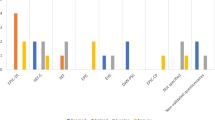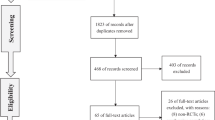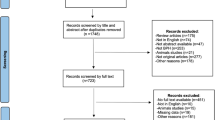Abstract
Background
Urinary and sexual dysfunction after radical prostatectomy remains a major cause of morbidity, despite widespread availability of pharmacological and rehabilitative treatments. Smoking is a modifiable risk factor known to correlate with erectile and urinary dysfunction and we hypothesise that smoking cessation may improve post-prostatectomy urinary and sexual function recovery. Our objective is to systematically evaluate literature describing the association of smoking status with urinary and sexual function in men following radical prostatectomy.
Methods
In total, 310 unique records were identified through a systematic search of the MEDLINE, EMBASE, Scopus, Web of Science, CINAHL and CENTRAL databases up to February 2023. Nine studies reported smoking status and post radical prostatectomy urinary and sexual function outcomes in men with localized prostate cancer. Risk of bias was assessed and meta-analysis included six studies.
Results
Smokers had inferior erectile function after prostatectomy compared to non-smokers (OR 0.73, [95% CI 0.56–0.95]) during follow-up, while urinary incontinence was not statistically different between groups (OR 1.20, [95% CI 0.75–1.91]). Smoking cessation improved the EPIC-26 sexual domain score with 6.6 points on average [p = 0.03] to a clinically significant maximum of 12.5 points at 18–24 months.
Conclusions
Smoking is associated with impaired sexual function recovery after radical prostatectomy and quitting may improve sexual function >18 months. Current evidence shows no such association for urinary outcomes. Further studies are needed to corroborate findings.
This is a preview of subscription content, access via your institution
Access options
Subscribe to this journal
Receive 4 print issues and online access
$259.00 per year
only $64.75 per issue
Buy this article
- Purchase on Springer Link
- Instant access to full article PDF
Prices may be subject to local taxes which are calculated during checkout



Similar content being viewed by others
References
Sung H, Ferlay J, Siegel RL, Laversanne M, Soerjomataram I, Jemal A, et al. Global cancer statistics 2020: GLOBOCAN estimates of incidence and mortality worldwide for 36 cancers in 185 countries. CA Cancer J Clin. 2021;71:209–49.
Siegel RL, Miller KD, Fuchs HE, Jemal A. Cancer statistics, 2022. CA Cancer J Clin. 2022;72:7–33.
Litwin MS, Melmed GY, Nakazon T. Life after radical prostatectomy: a longitudinal study. J Urol. 2001;166:587–92.
Stanford JL, Feng Z, Hamilton AS, Gilliland FD, Stephenson RA, Eley JW, et al. Urinary and sexual function after radical prostatectomy for clinically localized prostate cancer: the Prostate Cancer Outcomes Study. Jama 2000;283:354–60.
Lubeck DP, Litwin MS, Henning JM, Stoddard ML, Flanders SC, Carroll PR. Changes in health-related quality of life in the first year after treatment for prostate cancer: results from CaPSURE. Urology. 1999;53:180–6.
Litwin MS, Flanders SC, Pasta DJ, Stoddard ML, Lubeck DP, Henning JM. Sexual function and bother after radical prostatectomy or radiation for prostate cancer: multivariate quality-of-life analysis from CaPSURE. Cancer of the Prostate Strategic Urologic Research Endeavor. Urology. 1999;54:503–8.
Haglind E, Carlsson S, Stranne J, Wallerstedt A, Wilderäng U, Thorsteinsdottir T, et al. Urinary incontinence and erectile dysfunction after robotic versus open radical prostatectomy: a prospective, controlled, nonrandomised trial. Eur Urol. 2015;68:216–25.
Resnick MJ, Koyama T, Fan KH, Albertsen PC, Goodman M, Hamilton AS, et al. Long-term functional outcomes after treatment for localized prostate cancer. N Engl J Med. 2013;368:436–45.
Tal R, Alphs HH, Krebs P, Nelson CJ, Mulhall JP. Erectile function recovery rate after radical prostatectomy: a meta-analysis. J Sex Med. 2009;6:2538–46.
Smith DS, Carvalhal GF, Schneider K, Krygiel J, Yan Y, Catalona WJ. Quality-of-life outcomes for men with prostate carcinoma detected by screening. Cancer 2000;88:1454–63.
Smith DP, King MT, Egger S, Berry MP, Stricker PD, Cozzi P, et al. Quality of life three years after diagnosis of localised prostate cancer: population based cohort study. BMJ. 2009;339:b4817.
Papa N, O'Callaghan M, James E, Millar J. Prostate Cancer in Australian and New Zealand Men: Patterns of care withing PCOR-ANZ 2015-2018. Melbourne, Vic: Monash University & Movember; 2021.
Sanda MG, Dunn RL, Michalski J, Sandler HM, Northouse L, Hembroff L, et al. Quality of life and satisfaction with outcome among prostate-cancer survivors. N Engl J Med. 2008;358:1250–61.
Meyer JP, Gillatt DA, Lockyer R, Macdonagh R. The effect of erectile dysfunction on the quality of life of men after radical prostatectomy. BJU Int. 2003;92:929–31.
EAU – ESTRO – ESUR – SIOG Guidelines on Prostate Cancer. [Internet]. No date [cited 03-07-2021]. Available from: https://uroweb.org/guideline/prostate-cancer/.
Koskimäki J, Hakama M, Huhtala H, Tammela TL. Association of smoking with lower urinary tract symptoms. J Urol. 1998;159:1580–2.
Schauer I, Keller E, Müller A, Madersbacher S. Have rates of erectile dysfunction improved within the past 17 years after radical prostatectomy? A systematic analysis of the control arms of prospective randomized trials on penile rehabilitation. Andrology. 2015;3:661–5.
Ficarra V, Novara G, Artibani W, Cestari A, Galfano A, Graefen M, et al. Retropubic, laparoscopic, and robot-assisted radical prostatectomy: a systematic review and cumulative analysis of comparative studies. Eur Urol. 2009;55:1037–63.
Campodonico F, Manuputty EE, Campora S, Puntoni M, Maffezzini M. Age is predictive of immediate postoperative urinary continence after radical retropubic prostatectomy. Urol Int. 2014;92:276–81.
Lu C-H, Wu C-H, Chen Y-C, Chen C-H, Wu R, Lee Y-H, et al. Can robot-assisted radical prostatectomy improve functional outcomes compared to laparoscopic radical prostatectomy? Experience at a laparoscopic center. Urological Sci. 2019;30:124–30.
De Carlo F, Celestino F, Verri C, Masedu F, Liberati E, Di Stasi SM. Retropubic, laparoscopic, and robot-assisted radical prostatectomy: surgical, oncological, and functional outcomes: a systematic review. Urol Int. 2014;93:373–83.
McCullough AR. Prevention and management of erectile dysfunction following radical prostatectomy. Urol Clin North Am. 2001;28:613–27.
Basiri A, de la Rosette JJ, Tabatabaei S, Woo HH, Laguna MP, Shemshaki H. Comparison of retropubic, laparoscopic and robotic radical prostatectomy: who is the winner? World J Urol. 2018;36:609–21.
Pinkhasov RM, Lee T, Huang R, Berkley B, Pinkhasov AM, Dodge N, et al. Prediction of Incontinence after Robot-Assisted Radical Prostatectomy: Development and Validation of a 24-Month Incontinence Nomogram. Cancers. 2022;14:1644.
Agochukwu-Mmonu N, Murali A, Wittmann D, Denton B, Dunn RL, Montie J, et al. Development and validation of dynamic multivariate prediction models of sexual function recovery in patients with prostate cancer undergoing radical prostatectomy: results from the music statewide collaborative. Eur Urol Open Sci. 2022;40:1–8.
O'Callaghan ME, Raymond E, Campbell J, Vincent AD, Beckmann K, Roder D, et al. Tools for predicting patient-reported outcomes in prostate cancer patients undergoing radical prostatectomy: a systematic review of prognostic accuracy and validity. Prostate Cancer Prostatic Dis. 2017;20:378–88.
Lin D, O'Callaghan M, David R, Fuller A, Wells R, Sutherland P, et al. Does urethral length affect continence outcomes following robot assisted laparoscopic radical prostatectomy (RALP)? BMC Urol. 2020;20:8.
Brookman-May SD, Campi R, Henríquez JDS, Klatte T, Langenhuijsen JF, Brausi M, et al. Latest evidence on the impact of smoking, sports, and sexual activity as modifiable lifestyle risk factors for prostate cancer incidence, recurrence, and progression: a systematic review of the literature by the European Association of Urology Section of Oncological Urology (ESOU). Eur Urol Focus. 2019;5:756–87.
Allen MS, Walter EE. Health-related lifestyle factors and sexual dysfunction: a meta-analysis of population-based research. J Sex Med. 2018;15:458–75.
Gades NM, Nehra A, Jacobson DJ, McGree ME, Girman CJ, Rhodes T, et al. Association between smoking and erectile dysfunction: a population-based study. Am J Epidemiol. 2005;161:346–51.
Bacon CG, Mittleman MA, Kawachi I, Giovannucci E, Glasser DB, Rimm EB. A prospective study of risk factors for erectile dysfunction. J Urol. 2006;176:217–21.
Watson RA, Sadeghi-Nejad H. Tobacco abuse and the urologist: time for a more proactive role. Urology. 2011;78:1219–23.
Tengs TO, Osgood ND. The link between smoking and impotence: two decades of evidence. Prev Med. 2001;32:447–52.
Haidinger G, Temml C, Schatzl G, Brössner C, Roehlich M, Schmidbauer CP, et al. Risk factors for lower urinary tract symptoms in elderly men. For the Prostate Study Group of the Austrian Society of Urology. Eur Urol. 2000;37:413–20.
Rohrmann S, Crespo CJ, Weber JR, Smit E, Giovannucci E, Platz EA. Association of cigarette smoking, alcohol consumption and physical activity with lower urinary tract symptoms in older American men: findings from the third National Health And Nutrition Examination Survey. BJU Int. 2005;96:77–82.
John G. Urinary incontinence and cardiovascular disease: a narrative review. Int Urogynecol J. 2020;31:857–63.
Teloken PE, Nelson CJ, Karellas M, Stasi J, Eastham J, Scardino PT, et al. Defining the impact of vascular risk factors on erectile function recovery after radical prostatectomy. BJU Int. 2013;111:653–7.
Ku J, Krahn M, Trachtenberg J, Nesbitt M, Kalnin R, Lockwood G, et al. Changes in health utilities and health-related quality of life over 12 months following radical prostatectomy. Can Urol Assoc J 2009;3:445–52.
Sood A, Schmid M, Campbell L, Kapoor V, Abdollah F, Klett DE, et al. Impact of smoking on perioperative outcomes after major urologic surgery. J Urol. 2015;193:e105.
Bjurlin MA, Cohn MR, Kim DY, Freeman VL, Lombardo L, Hurley SD, et al. Brief smoking cessation intervention: a prospective trial in the urology setting. J Urol. 2013;189:1843–9.
Sosnowski R, Bjurlin MA, Verze P, De Nunzio C, Shariat SF, Brausi M, et al. Role of cigarette smoking in urological malignancies and clinical interventions for smoking cessation. Cent Eur J Urol. 2016;69:366–9.
Eastham JA, Auffenberg GB, Barocas DA, Chou R, Crispino T, Davis JW, et al. Clinically localized prostate cancer: AUA/ASTRO guideline, part i: introduction, risk assessment, staging, and risk-based management. J Urol. 2022;208:10–8.
Affentranger A, Matulewicz RS, Fankhauser CD Why and how smoking cessation must be implemented in urology clinics as a standard of care. Eur Urol. 2022;82:245–6.
Page MJ, McKenzie JE, Bossuyt PM, Boutron I, Hoffmann TC, Mulrow CD, et al. The PRISMA 2020 statement: an updated guideline for reporting systematic reviews. BMJ. 2021;372:n71.
Booth A, Clarke M, Ghersi D, Moher D, Petticrew M, Stewart L. An international registry of systematic-review protocols. Lancet. 2011;377:108–9.
The association between smoking and urinary and sexual function following radical prostatectomy for localized prostate cancer, a systematic literature review. PROSPERO 2022 CRD42022337108 [Internet]. Available from: https://www.crd.york.ac.uk/prospero/display_record.php?ID=CRD42022337108.
Thompson M, Tiwari A, Fu R, Moe E, Buckley DI. AHRQ Methods for Effective Health Care. A Framework To Facilitate the Use of Systematic Reviews and Meta-Analyses in the Design of Primary Research Studies. Rockville (MD): Agency for Healthcare Research and Quality (US); 2012.
Covidence systematic review software. Melbourne, Australia: Veritas Health Innovation.
Katz MH. Multivariable analysis: a practice guide for clinicians. New York, NY: Cambridge University Press; 1999.
Review Manager (RevMan). Version 5.4.1. The Cochrane Collaboration. 2020.
Stroup DF, Berlin JA, Morton SC, Olkin I, Williamson GD, Rennie D, et al. Meta-analysis of observational studies in epidemiology: a proposal for reporting. Meta-analysis Of Observational Studies in Epidemiology (MOOSE) group. JAMA. 2000;283:2008–12.
Wells GA, Shea B, O'Connell D, Peterson J, Welch V, Losos M, et al. The Newcastle-Ottawa Scale (NOS) for assessing the quality of nonrandomised studies in meta-analyses2021 [cited 2022 12 Oct]. Available from: https://www.ohri.ca/programs/clinical_epidemiology/oxford.asp.
Wolff RF, Moons KGM, Riley RD, Whiting PF, Westwood M, Collins GS, et al. PROBAST: a tool to assess the risk of bias and applicability of prediction model studies. Ann Intern Med. 2019;170:51–8.
Safavy S, Kilday PS, Slezak JM, Abdelsayed GA, Harrison TN, Jacobsen SJ, et al. Effect of a smoking cessation program on sexual function recovery following robotic prostatectomy at kaiser permanente Southern California. Perm J. 2017;21:16–138.
Marien T, Sankin A, Lepor H. Factors predicting preservation of erectile function in men undergoing open radical retropubic prostatectomy. J Urol. 2009;181:1817–22.
Anderson CB, Kaufman MR, Dietrich MS, Barocas DA, Chang SS, Cookson MS, et al. Recovery of urinary function after radical prostatectomy: identification of trajectory cluster groups. J Urol. 2012;187:1346–51.
Rajih E, Meskawi M, Alenizi AM, Zorn KC, Alnazari M, Zanaty M, et al. Perioperative predictors for post-prostatectomy urinary incontinence in prostate cancer patients following robotic-assisted radical prostatectomy: Long-term results of a Canadian prospective cohort. Can Urol Assoc J 2019;13:E125–e31.
Salter CA, Tin AL, Bernie HL, Nascimento B, Katz DJ, Benfante NE, et al. Predictors of worsening erectile function in men with functional erections early after radical prostatectomy. J Sex Med. 2022;19:1790–6.
Haskins AE, Han PK, Lucas FL, Bristol I, Hansen M. Development of clinical models for predicting erectile function after localized prostate cancer treatment. Int J Urol. 2014;21:1227–33.
Mao Q, Lin Y, Chen H, Bai Y, Qin J, Zheng X, et al. Preoperative risk factors for early postoperative urinary continence recovery after non-nerve-sparing radical prostatectomy in Chinese patients: a single institute retrospective analysis. Int J Clin Exp Med. 2015;8:14105–9.
Siltari A, Riikonen J, Fode M, Murtola TJ. Effects of preoperative atorvastatin treatment on erectile function after radical prostatectomy: results from a subgroup of ESTO1, a randomized, double-blind, placebo-controlled study. J Sex Med. 2019;16:1597–605.
Wille S, Heidenreich A, von Knobloch R, Hofmann R, Engelmann U. Impact of comorbidities on post-prostatectomy incontinence. Urol Int. 2006;76:223–6.
Van der Aa F, Drake MJ, Kasyan GR, Petrolekas A, Cornu JN. The artificial urinary sphincter after a quarter of a century: a critical systematic review of its use in male non-neurogenic incontinence. Eur Urol. 2013;63:681–9.
Ficarra V, Novara G, Rosen RC, Artibani W, Carroll PR, Costello A, et al. Systematic review and meta-analysis of studies reporting urinary continence recovery after robot-assisted radical prostatectomy. Eur Urol. 2012;62:405–17.
Litwin MS, Hays RD, Fink A, Ganz PA, Leake B, Brook RH. The UCLA Prostate Cancer Index: development, reliability, and validity of a health-related quality of life measure. Med Care. 1998;36:1002–12.
Rosen RC, Riley A, Wagner G, Osterloh IH, Kirkpatrick J, Mishra A. The international index of erectile function (IIEF): a multidimensional scale for assessment of erectile dysfunction. Urology. 1997;49:822–30.
Szymanski KM, Wei JT, Dunn RL, Sanda MG. Development and validation of an abbreviated version of the expanded prostate cancer index composite instrument for measuring health-related quality of life among prostate cancer survivors. Urology. 2010;76:1245–50.
Rosen RC, Cappelleri JC, Smith MD, Lipsky J, Peña BM. Development and evaluation of an abridged, 5-item version of the International Index of Erectile Function (IIEF-5) as a diagnostic tool for erectile dysfunction. Int J Impot Res. 1999;11:319–26.
Cappelleri JC, Rosen RC. The Sexual Health Inventory for Men (SHIM): a 5-year review of research and clinical experience. Int J Impot Res. 2005;17:307–19.
Junge B, Nagel M. [Smoking behavior in Germany]. Gesundheitswesen. 1999;61:S121–5.
Lampert T, Burger M. [Smoking habits in Germany—results of the German National Telephone Health Survey 2003]. Gesundheitswesen. 2004;66:511–7.
Talcott JA, Clark JA, Stark PC, Mitchell SP. Long-term treatment related complications of brachytherapy for early prostate cancer: a survey of patients previously treated. J Urol. 2001;166:494–9.
Boettcher M, Haselhuhn A, Jakse G, Brehmer B, Kirschner-Hermanns R. Overactive bladder syndrome: an underestimated long-term problem after treatment of patients with localized prostate cancer? BJU Int. 2012;109:1824–30.
Rosen RC, Allen KR, Ni X, Araujo AB. Minimal clinically important differences in the erectile function domain of the International Index of Erectile Function scale. Eur Urol. 2011;60:1010–6.
Skolarus TA, Dunn RL, Sanda MG, Chang P, Greenfield TK, Litwin MS, et al. Minimally important difference for the expanded prostate cancer index composite short form. Urology. 2015;85:101–5.
Mons U, Müezzinler A, Gellert C, Schöttker B, Abnet CC, Bobak M, et al. Impact of smoking and smoking cessation on cardiovascular events and mortality among older adults: meta-analysis of individual participant data from prospective cohort studies of the CHANCES consortium. BMJ. 2015;350:h1551.
U.S. Department of Health and Human Services. Cardiovascular Diseases, Chapter 6. How Tobacco Smoke Causes Disease: The Biology and Behavioral Basis for Smoking-Attributable Disease: A Report of the Surgeon General. Atlanta, US: Department of Health and Human Services, Centers for Disease Control and Prevention, National Center for Chronic Disease Prevention and Health Promotion, Office on Smoking and Health; 2010. 355-62.
Acknowledgements
A research scholarship was obtained from the Freemasons Center for Male Health & Wellbeing and the Flinders Foundation, who were not involved in the initiation or execution of this study.
Author information
Authors and Affiliations
Contributions
JV: Conceptualization, Methodology, Investigation, Data Curation, Analysis, Visualization, Original Draft. MH: Investigation, Data Curation, Analysis, Reviewing and Editing. BB: Reviewing and Editing, Supervision. M’OC: Conceptualization, Methodology, Analysis, Reviewing and Editing, Supervision.
Corresponding author
Ethics declarations
Competing interests
The authors declare no competing interests.
Additional information
Publisher’s note Springer Nature remains neutral with regard to jurisdictional claims in published maps and institutional affiliations.
Supplementary information
Rights and permissions
Springer Nature or its licensor (e.g. a society or other partner) holds exclusive rights to this article under a publishing agreement with the author(s) or other rightsholder(s); author self-archiving of the accepted manuscript version of this article is solely governed by the terms of such publishing agreement and applicable law.
About this article
Cite this article
Visscher, J., Hiwase, M., Bonevski, B. et al. The association of smoking with urinary and sexual function recovery following radical prostatectomy for localized prostate cancer: a systematic review and meta-analysis. Prostate Cancer Prostatic Dis (2023). https://doi.org/10.1038/s41391-023-00701-2
Received:
Revised:
Accepted:
Published:
DOI: https://doi.org/10.1038/s41391-023-00701-2



